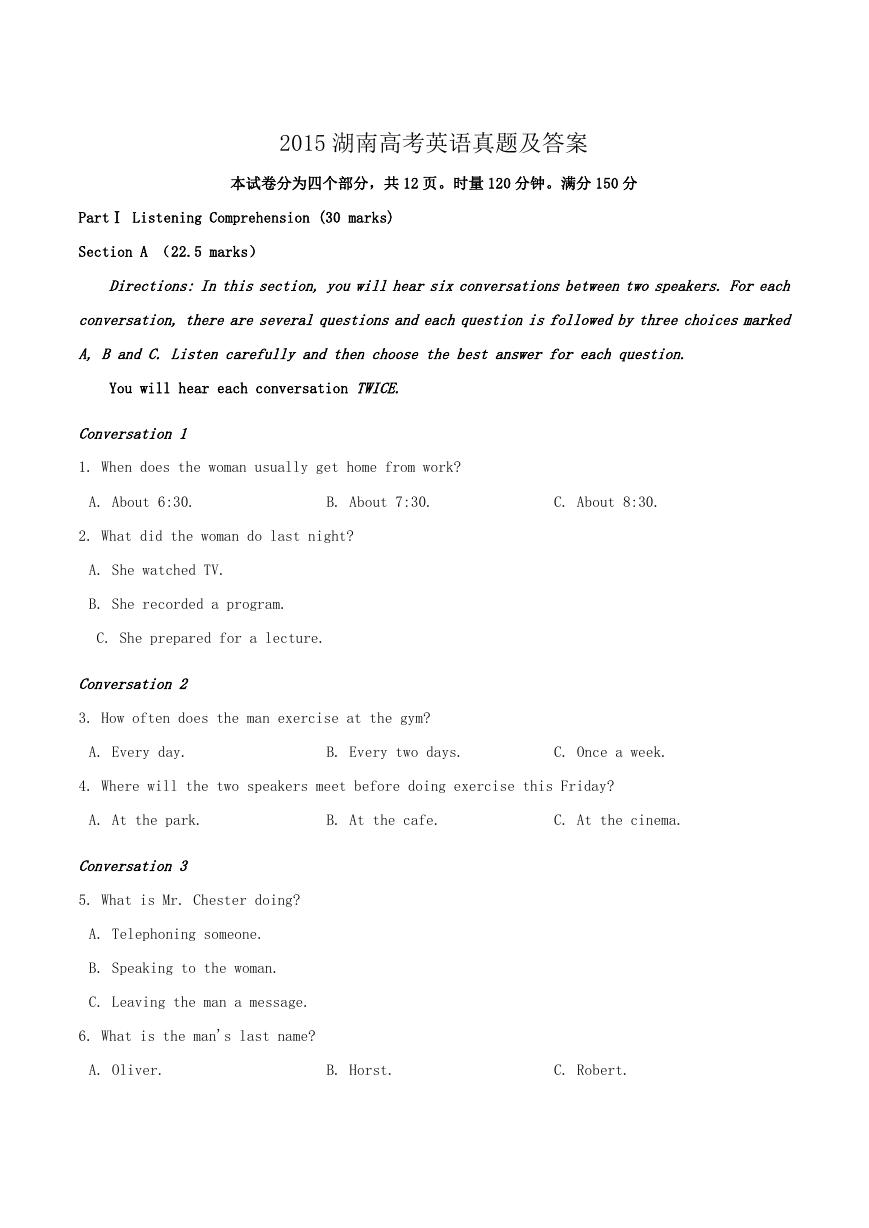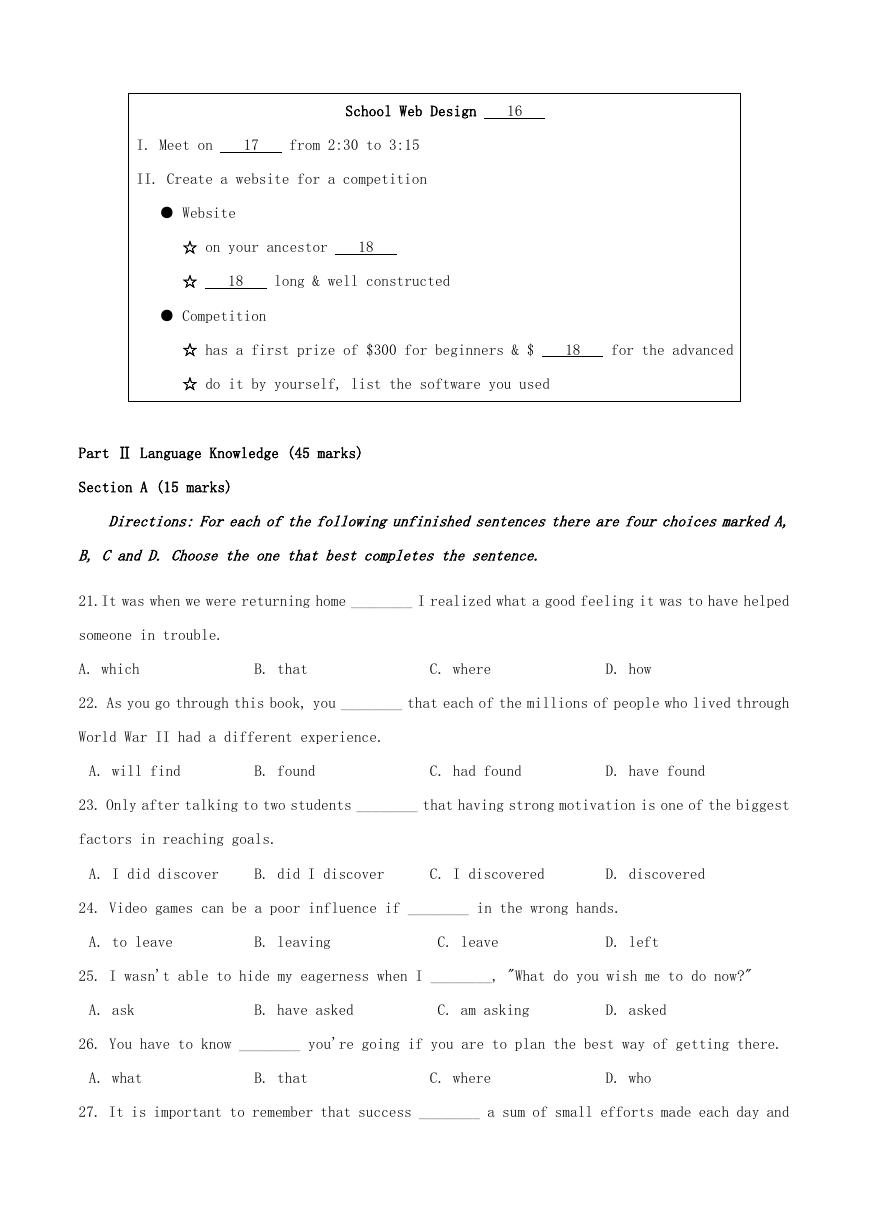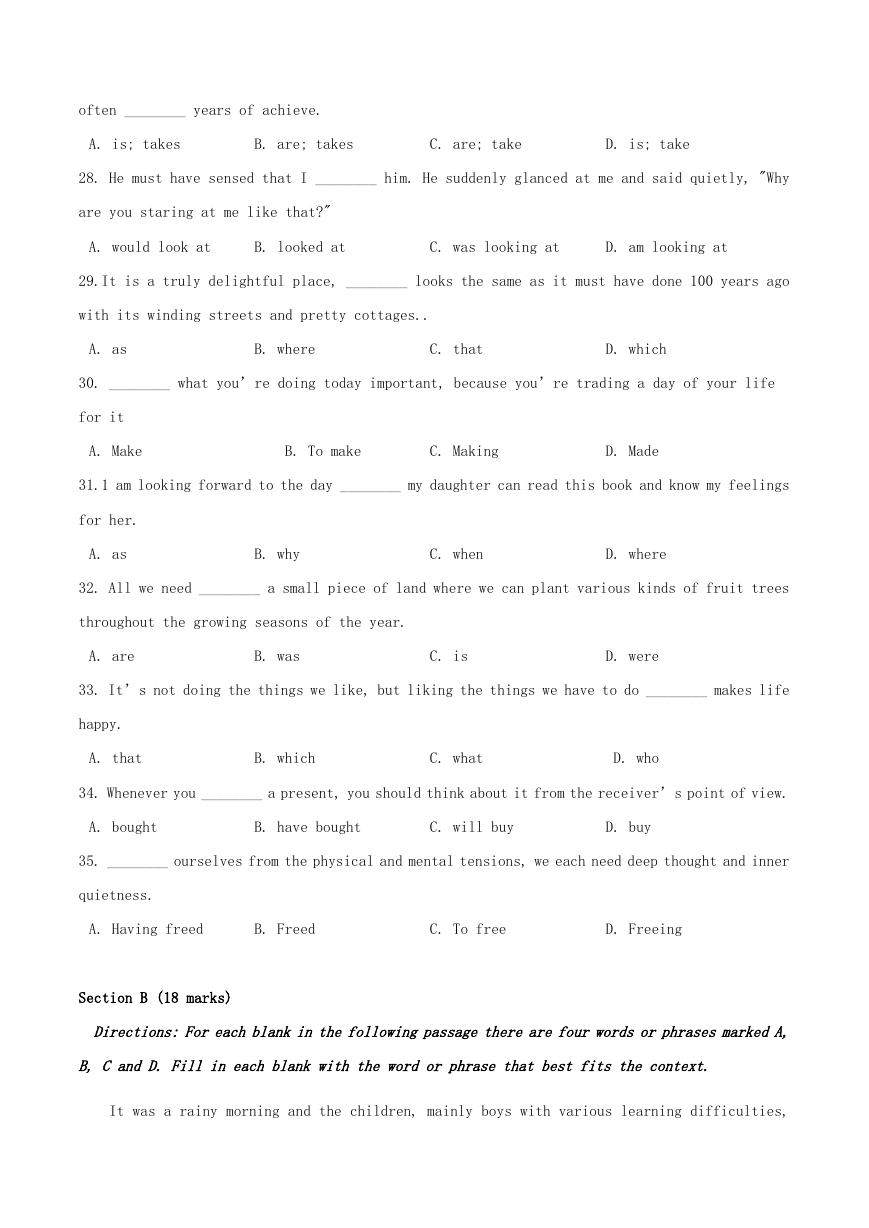2015 湖南高考英语真题及答案
本试卷分为四个部分,共 12 页。时量 120 分钟。满分 150 分
PartⅠ Listening Comprehension (30 marks)
Section A (22.5 marks)
Directions:Inthissection,youwillhearsixconversationsbetweentwospeakers.Foreach
conversation,thereareseveralquestionsandeachquestionisfollowedbythreechoicesmarked
A, B and C. Listen carefully and then choose the best answer for each question.
You will hear each conversation TWICE.
Conversation 1
1. When does the woman usually get home from work?
A. About 6:30.
B. About 7:30.
C. About 8:30.
2. What did the woman do last night?
A. She watched TV.
B. She recorded a program.
C. She prepared for a lecture.
Conversation 2
3. How often does the man exercise at the gym?
A. Every day.
B. Every two days.
C. Once a week.
4. Where will the two speakers meet before doing exercise this Friday?
A. At the park.
B. At the cafe.
C. At the cinema.
Conversation 3
5. What is Mr. Chester doing?
A. Telephoning someone.
B. Speaking to the woman.
C. Leaving the man a message.
6. What is the man's last name?
A. Oliver.
B. Horst.
C. Robert.
�
Conversation 4
7. Why will the woman be late?
A. She didn't catch the train.
B. She didn't finish her paper.
C. She didn't wake up in time.
8. Where is the man?
A. At the station.
B. At home.
C. At the office.
9. What is the probable relationship between the two speakers?
A. Teacher and student.
B. Parent and child.
C. Husband and wife.
Conversation 5
10. For whom does the woman buy the T-shirt?
A. Herself.
B. Her husband.
C. Her friend.
11 .How much does the T-shirt normally cost?
A. $54.
B. $60.
C. $70.
12. Why does the salesman agree to sell the T-shirt at $48?
A. It is cheaper online.
B. He is in a hurry.
C. A button is lost.
Conversation 6
13. When did the woman arrive?
A. Friday.
B. Saturday.
C. Sunday.
14. What major did the man choose in the end?
A. English.
B. Biology.
C . History.
15. What suggestion does the man give on reading the books?
A. Making notes.
B. Skimming first.
C. Reading word by word.
Section B(7.5 marks)
Directions: In this section, you will hear a short passage. Listen carefully and then fill
inthenumberedblankswiththeinformationyouhaveheard.FillineachblankwithNOMORETHAN
THREE WORDS.
You will hear the short passage TWICE
�
School Web Design
16
I. Meet on
17
from 2:30 to 3:15
II. Create a website for a competition
● Website
☆ on your ancestor
18
☆
18
long & well constructed
● Competition
☆ has a first prize of $300 for beginners & $
18
for the advanced
☆ do it by yourself, list the software you used
Part Ⅱ Language Knowledge (45 marks)
Section A (15 marks)
Directions:ForeachofthefollowingunfinishedsentencestherearefourchoicesmarkedA,
B, C and D. Choose the one that best completes the sentence.
21.It was when we were returning home ________ I realized what a good feeling it was to have helped
someone in trouble.
A. which
B. that
C. where
D. how
22. As you go through this book, you ________ that each of the millions of people who lived through
World War II had a different experience.
A. will find
B. found
C. had found
D. have found
23. Only after talking to two students ________ that having strong motivation is one of the biggest
factors in reaching goals.
A. I did discover
B. did I discover
C. I discovered
D. discovered
24. Video games can be a poor influence if ________ in the wrong hands.
A. to leave
B. leaving
C. leave
D. left
25. I wasn't able to hide my eagerness when I ________, "What do you wish me to do now?"
A. ask
B. have asked
C. am asking
D. asked
26. You have to know ________ you're going if you are to plan the best way of getting there.
A. what
B. that
C. where
D. who
27. It is important to remember that success ________ a sum of small efforts made each day and
�
often ________ years of achieve.
A. is; takes
B. are; takes
C. are; take
D. is; take
28. He must have sensed that I ________ him. He suddenly glanced at me and said quietly, "Why
are you staring at me like that?"
A. would look at
B. looked at
C. was looking at
D. am looking at
29.It is a truly delightful place, ________ looks the same as it must have done 100 years ago
with its winding streets and pretty cottages..
A. as
B. where
C. that
D. which
30. ________ what you’re doing today important, because you’re trading a day of your life
for it
A. Make
B. To make
C. Making
D. Made
31.1 am looking forward to the day ________ my daughter can read this book and know my feelings
for her.
A. as
B. why
C. when
D. where
32. All we need ________ a small piece of land where we can plant various kinds of fruit trees
throughout the growing seasons of the year.
A. are
B. was
C. is
D. were
33. It’s not doing the things we like, but liking the things we have to do ________ makes life
happy.
A. that
B. which
C. what
D. who
34. Whenever you ________ a present, you should think about it from the receiver’s point of view.
A. bought
B. have bought
C. will buy
D. buy
35. ________ ourselves from the physical and mental tensions, we each need deep thought and inner
quietness.
A. Having freed
B. Freed
C. To free
D. Freeing
Section B (18 marks)
Directions:ForeachblankinthefollowingpassagetherearefourwordsorphrasesmarkedA,
B, C and D. Fill in each blank with the word or phrase that best fits the context.
It was a rainy morning and the children, mainly boys with various learning difficulties,
�
refused to settle for the start of the lesson. As an inexperienced teacher, I tried every means
to get them to be
36
, but in vain. my panic was rising and I could feel my heart beating wildly.
This was the
37
of my job as a music teacher, I thought -- teaching was not for me. Then I
had an idea. Hoping that no one would notice that I was
38
inside, I threw my voice as far
as it would reach: "Put your heads on the desks and close your
39
! We are going on a journey."
40
, the children fell silent. "Now what should I do?" I thought to myself. Reaching over
to my collection of CDs, I blindly
41
, put it in the machine and played it.
Obediently (顺从地), my class lay their heads on their desk, closed their eyes and
42 .
When the music started, the room as filled with the most beautiful tones and musical colors I
could have ever imagined. All the children were
43
. When the music finished, I asked them
all to raise their
44
slowly so that we could share our musical journey.
At this point, when all the children were willing to share their experiences, I began to learn
how to
45
. The music allow me to learn that teaching is about sharing and respect, tears and
smiles, the knowing and the
46
and most of all, an understanding of each other. This was the power that
47
in the
classroom could have.
36. A. glad
37.A. end
B. safe
B. aim
C. kind
C. rule
D. quiet
D. plan
38. A. guessing
B. shaking
C. responding
D. laughing
39. A. eyes
B. mouths
C. books
D. doors
40. A. Punctually
B. Importantly
C. Amazingly
D. Obviously
41. A. passed one on
B. gave one back
C. turned one in
D. took one out
42. A. slept
B. nodded
C. waited
D. continued
43. A. talking
B. singing
C. dancing
D. listening
44. A. legs
B. heads
45. A. teach
B. imagine
C. arms
C. play
D. shoulders
D. understand
46. A. unprepared
B. unspoken
C. unknown
D. unforgotten
47. A. games
B. music
C. tears
D. knowledge
Section C (12 marks)
�
Directions:Completethefollowingpassagebyfillingineachblankwithonewordthatbest
fits the context.
Research has become both simpler and more complex. It's simpler because,
48
you have
computer, you can find information you need by searching the Internet. For all you information,
you don't have to go to
49
library to find the relevant resource and take notes on it. Instead,
you can find some sources from the Internet
50
print the copies needed. Remember, however, that you should usually consult different types
of sources. That is, you
51
always rely just on the Internet for you research.
While finding information is easier than ever, at the same time, researching has become
52
complex. There is a lot more material available, which means you may be overwhelmed
53
the
amount of information. You need to learn
54
to sort through and find the relevant information
for your particular project. Also,
5547
need to check the accuracy of it.
Part Ⅲ Reading Comprehension (30 marks)
Directions:Readthefollowingthreepassages.Eachpassageisfollowedbyseveralquestions
or unfinished .statements For each of them there are four chokes marked A. B. C and D. Choose
the one that fits best according to the information given in the passage.
A
Forget Cyclists, Pedestrians are Real Danger
We are having a debate about this topic. Here are some letters from our readers.
■Yes, many cyclists behave dangerously. Many drivers are disrespectful of cyclists. But
pedestrians are probably the worse offenders.
People of all ages happily walk along the pavement with eyes and hands glued to the mobile
phone, quite unaware of what is going on around them. They may even do the same thing while crossing
a road at a pedestrian crossing or elsewhere. The rest of us have to evade (避让) them or just
stand still to wait for the unavoidable collision.
The real problem is that some pedestrians seem to be, at least for the moment, in worlds
of their own that are, to them, much more important than the welfare of others.
�
——Michael Horan
■I love the letter from Bob Brooks about cyclists (Viewpoints, May 29). I am afraid they
seem to think they own the roads.
I was walking across Altrincham Road one morning when a cyclist went round me and on being
asked what he was doing he shouted at me.
The government built a cycle lane on the road but it is hardly used.
The police do nothing. What a laugh they are!
The cyclists should all have to be made to use the cycle lanes and wear helmets, fluorescent
(发荧光的) jacket and lights at night and in the morning they should pay some sort of tax and
be fined for not wearing them.
——Carol Harvey
■Cyclists jump on and off pavements (which are meant for pedestrians), ride at speed along
the pavements, and think they have a special right to go through traffic lights when they are
on red.
I was almost knocked down recently by a cyclist riding on the pavement when there was a cycle
lane right next to him.
Other road users, including horse riders, manage to obey the rules so why not cyclists?
It's about time they had to be registered and insured, so when they do hit a pedestrian or
a vehicle, or cause an accident, at least they can be treated and there might be an opportunity
to claim.
——JML
Write to Viewpoints of the newspaper.
56. Michael Horan wrote the letter mainly to show that _______.
A. drivers should be polite to cyclists
B. road accidents can actually be avoided
C. sine pedestrians are a threat to road safety
D. walking while using phones hurts one's eyes
57. Carol Harvey suggests that cyclists should _______.
A. be provided with enough roads
�
B. be asked to ride on their own lanes
C. be made to pay less tax for cycling
D. be fined for laughing at policemen
58. What is a complaint of JML?
A. Very few drivers are insured.
B. Cyclists ride fast on pavements.
C. Pedestrians go through red traffic lights.
D. Horse riders disrespect other road users.
59. The underlined word "they" in the third letter refers to ______.
A. accidents
C. pedestrians
B. vehicles
D. cyclists
60. The three letters present viewpoints on _______.
A. real source of road danger
B. ways to improve road facilities
C. measures to punish road offences
D. increased awareness of road rules
B
In its early history, Chicago had floods frequently, especially in the spring, making the
streets so muddy that people, horses, and carts got stuck. An old joke that was popular at the
time went something like this: A man is stuck up to his waist in a muddy Chicago street. Asked
if he needs help, he replies, "No, thanks. I've got a good horse under me."
The city planner decided to build an underground drainage (排水) system, but there simply
wasn't enough difference between the height of the ground level and the water level. The only
two options were to lower the Chicago River or raise the city.
An engineer named Ellis Chesbrough convinced me the city that it had no choice but to build
the pipes above ground and then cover them with dirt. This raised the level of the city's streets
by as much as 12 feet.
This of course created a new problem: dirt practically buried the first floors of every building
in Chicago. Building owners were faced with a choice: either change the first floors of their
�
















 2023年江西萍乡中考道德与法治真题及答案.doc
2023年江西萍乡中考道德与法治真题及答案.doc 2012年重庆南川中考生物真题及答案.doc
2012年重庆南川中考生物真题及答案.doc 2013年江西师范大学地理学综合及文艺理论基础考研真题.doc
2013年江西师范大学地理学综合及文艺理论基础考研真题.doc 2020年四川甘孜小升初语文真题及答案I卷.doc
2020年四川甘孜小升初语文真题及答案I卷.doc 2020年注册岩土工程师专业基础考试真题及答案.doc
2020年注册岩土工程师专业基础考试真题及答案.doc 2023-2024学年福建省厦门市九年级上学期数学月考试题及答案.doc
2023-2024学年福建省厦门市九年级上学期数学月考试题及答案.doc 2021-2022学年辽宁省沈阳市大东区九年级上学期语文期末试题及答案.doc
2021-2022学年辽宁省沈阳市大东区九年级上学期语文期末试题及答案.doc 2022-2023学年北京东城区初三第一学期物理期末试卷及答案.doc
2022-2023学年北京东城区初三第一学期物理期末试卷及答案.doc 2018上半年江西教师资格初中地理学科知识与教学能力真题及答案.doc
2018上半年江西教师资格初中地理学科知识与教学能力真题及答案.doc 2012年河北国家公务员申论考试真题及答案-省级.doc
2012年河北国家公务员申论考试真题及答案-省级.doc 2020-2021学年江苏省扬州市江都区邵樊片九年级上学期数学第一次质量检测试题及答案.doc
2020-2021学年江苏省扬州市江都区邵樊片九年级上学期数学第一次质量检测试题及答案.doc 2022下半年黑龙江教师资格证中学综合素质真题及答案.doc
2022下半年黑龙江教师资格证中学综合素质真题及答案.doc